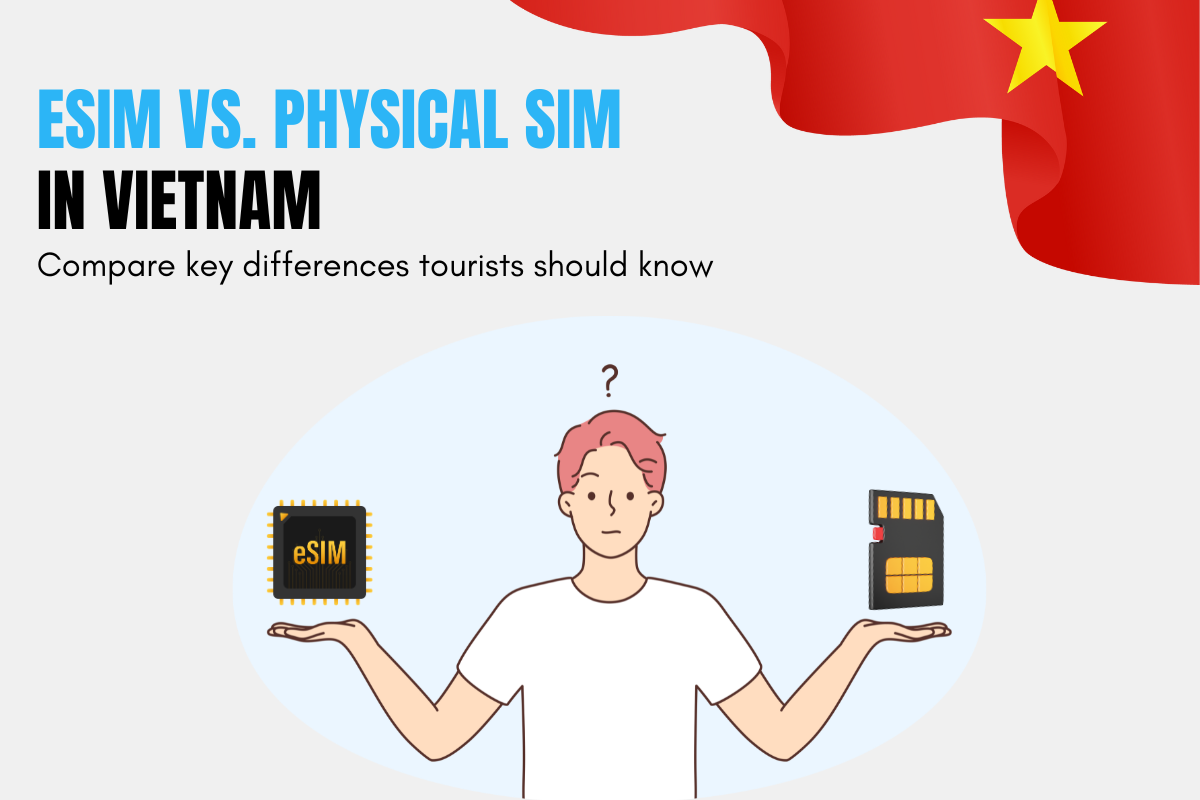Staying connected is essential for tourists visiting Vietnam, whether for navigating Hanoi’s streets, sharing travel moments, or booking services. Travelers have two main options: eSIM or physical SIM cards. But which one is better for your trip? This guide will explain the differences between eSIM vs. physical SIM in Vietnam, help you make an informed choice, and show why an eSIM is often the best option.

I. What is an eSIM?
An eSIM, or “embedded SIM,” is a digital version of a physical SIM card. Instead of inserting a chip, you download and activate the eSIM via a QR code or app. It’s built into many modern smartphones, making carrier switching easy without handling physical cards. For tourists, eSIMs are ideal as they can be activated online within minutes, even before arriving in Vietnam.
II. What is a Physical SIM Card?
A physical SIM card is the traditional way to connect to a mobile network. In Vietnam, these small chips are widely available and cater to tourists with short-term data plans. However, buying one often requires visiting a store, swapping your existing SIM card, and dealing with potential language barriers or queues.
II. Compare eSIM vs Physical SIM: Key Differences
When deciding between eSIM and physical SIM cards, it’s important to consider factors like activation, convenience, compatibility, and availability. The table below compares the two options:
| Feature | eSIM | Physical SIM |
| Activation | Digital; activate online before arrival. | Buy in person and manually insert. |
| Convenience | No swapping cards; keep your home SIM active (dual-SIM). | Requires removing your current SIM, risking loss or damage. |
| Compatibility | Works with eSIM-supported, unlocked smartphones. | Works with any unlocked phone. |
| Availability | Purchase online from providers like vietnamesim.com. | Available at airports, telecom stores, and convenience shops in Vietnam. |
| Cost | Affordable tourist data plans with no hidden fees. | Slightly less expensive, but airport SIMs may cost more. |
| Time-Saving | Instant activation saves time upon arrival. | Buying a SIM in person can be time-consuming. |
III. Who Provides Vietnam SIM and eSIM?
1. Vietnam SIM Providers
Physical SIM cards are offered by major telecom operators like Viettel, Vinaphone, and MobiFone. These providers have dedicated tourist SIM cards with short-term data plans.
2. Vietnam eSIM Providers
Tourists can purchase eSIM plans online from eSIM providers such as Gigago, Vietnamesim or local telecom providers, such as Viettel, also offer eSIMs for domestic users, though they may not be as convenient for tourists. It is recommended to choose the eSIM provider like Vietnamesim.com who is specifically designed to cater to international travelers to Vietnam and does not require complicated registration process.
IV. Where to Buy Vietnam SIM and eSIM?
Where to Buy Physical SIM Cards:
- You can purchase physical SIM cards at Vietnam’s international airports (e.g., Tan Son Nhat in Ho Chi Minh City or Noi Bai in Hanoi), telecom stores, or convenience shops in major cities.
- While convenient, buying at the airport may cost slightly more than in the city.
Where to Buy eSIMs:
- eSIMs can be purchased online from providers like vietnamesim.com. This allows you to activate your plan before arriving in Vietnam, saving time and avoiding potential language barriers.
Buy Vinaphone eSIMs for Vietnam
Buy Viettel eSIM plans for Vietnam
Buy MobiFone eSIM plans for Vietnam
V. Why eSIM is the Best Option for Tourists
For most tourists, an eSIM offers unparalleled convenience and efficiency. Here’s why:
- Ease of Access: An eSIM can be purchased and activated online before departure, ensuring you’re connected as soon as you land in Vietnam.
- Time-Saving: Skip the hassle of finding a SIM card store or queuing at the airport.
- Dual-SIM Functionality: Use your home SIM for calls and texts while relying on the eSIM for affordable data plans.
- Reliable Network: Providers like vietnamesim.com offer affordable data plans with excellent nationwide coverage, even in remote areas.
VI. How to Choose the Right Option for Your Trip
1. Choose eSIM if:
- Your smartphone supports eSIM technology.
- You want a hassle-free experience and the ability to activate your plan before arrival.
- Staying connected immediately upon landing is a priority.
2. Choose Physical SIM if:
- Your phone doesn’t support eSIMs.
- You prefer buying in person and don’t mind spending extra time at a store or airport.
To sum up, both eSIMs and physical SIM cards have their advantages, but for most tourists, eSIMs are the clear winner in terms of convenience, time-saving, and ease of use.
